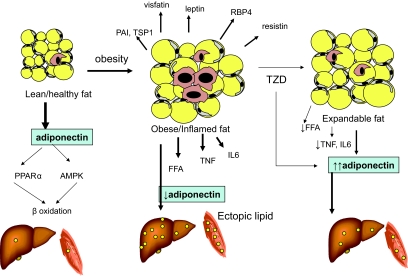Figure 2.
Changes in adipose tissue, liver, and muscle with obesity and insulin resistance. The adipose tissue of lean subjects contains few macrophages, and secretes relatively high levels of adiponectin, and low levels of inflammatory cytokines. β-Oxidation of lipids in muscle is high, and there is little ectopic fat in the muscle and liver. With obesity and insulin resistance, adipose tissue contains many macrophages, and the tissue secretes high levels of many adipokines, and low levels of adiponectin. This adipose tissue may be limited in its lipid storage capacity, and this feature, along with the pro-inflammatory state, promotes ectopic lipid accumulation. The adipose tissue in some subjects can be characterized as expandable, meaning the tissue can accommodate more lipid. This may result from treatment with a TZD. Such adipose tissue may be less inflamed, and because this adipose tissue can accumulate more lipid, there is less ectopic fat.

